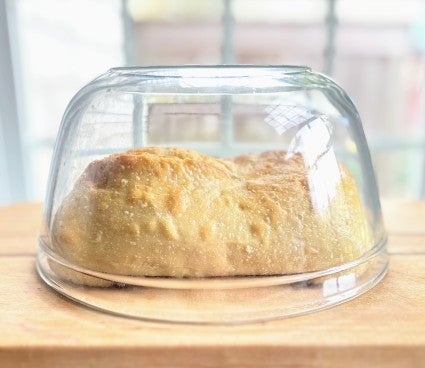How to store sourdough bread
Lock in freshness with these simple techniques.


Homemade sourdough bread is near perfection: crispy and crackly on the outside, soft and supple on the inside. The one downside? It's best the day it's baked; as time passes, it gradually loses its luster. But if you store sourdough bread the right way, you can keep it fresh for longer, so each bite is closer to those enticing first few hours.
So, what’s the best way to store sourdough bread?

The typical sourdough loaf most people envision is a crusty boule or round, scored on top and with an open crumb structure (that is, a lot of holes).
But that’s not the only type of sourdough out there — there are plenty of recipes for soft sourdough bread, like these soft sourdough dinner rolls and this sourdough sandwich loaf. These two types of sourdough bread — crusty vs. soft — need to be stored differently.

Soft sourdough bread (either a loaf or rolls) is best stored in an airtight bag at room temperature. Plastic (or beeswax-coated cotton) will lock in the bread’s moisture, keeping it fresh for up to a week at room temperature — though as the days pass you might want to refresh single servings by toasting briefly.
You might be worried that moist, soft bread might start to mold if kept for more than a couple of days at room temperature. Thankfully, sourdough bread’s pH helps keep it mold-free days longer than non-sourdough bread.
If you’re baking sourdough baguettes, a fat round, or another artisan-style loaf, a non-breathable bag is the last place you’ll want to store it; the airtight wrapping will soften your bread’s crunchy crust within hours. Instead, here are the best options for storing crusty sourdough bread — both for up to a day and longer.

Say you baked your sourdough loaf in the morning and want to serve it that night for dinner. Place the hot bread on a cooling rack and leave it uncovered; for best results, let it cool completely before slicing. Its crust will soften a little bit as moisture from the interior migrates to the surface and evaporates, but in general, it’ll remain fairly crunchy on the outside while the inside will be nicely moist.

If you’re not going to serve your loaf until the next day, let it cool completely on a cooling rack, then place it on a cutting board or on your counter. Cover it with a cake cover or a large bowl, something big enough for air to circulate. Being loosely enclosed will help keep the bread’s interior moist, but the circulating air will also encourage its crust to remain crispy.
Another option is a micro-perforated “breathable” plastic bag, often found holding artisan loaves in your supermarket’s bakery department. The balance between letting air in via the holes and keeping it out via plastic works fairly well.
After 24 hours, you should bag your loaf. While large, whole-grain rounds or oval loaves have more moisture-retaining properties (and will stay fresh longer than smaller, thinner loaves made with all-purpose or bread flour), all sourdough bread needs extra protection after 24 hours.

So, paper, plastic, or cloth: which type of bag works best?
Our tests show that paper doesn’t prevent the crust from softening and hastens the interior's staling. Cloth bags (or a kitchen towel) are slightly better than paper, as they allow the bread to breathe but retain some moisture; the crust will harden, and the interior will dry more slowly.
Whether you’ve sliced your bread or left it intact, an airtight bag is your top choice for sourdough bread stored at room temperature for longer than a day. A reusable beeswax-lined cotton bag like this Reusable Bread Bag works very well and is a sensible way to reduce plastic waste: Simply slip your loaf into the beeswax coated liner, roll down the top and use the warmth of your hands to seal it, then slip it inside the cloth bag. If you choose plastic, heavy-duty plastic bread bags are sturdy enough to use multiple times; just rinse them out between loaves.

Freezing (rather than refrigeration, which dries bread out very quickly) is a great storage option. You can freeze the loaf whole, but for flexibility in serving and ease of handling, it’s best to slice the bread before bagging airtight, separating each portion (one or two slices) with a bit of parchment between the slices so they don’t stick to one another.
To reheat bread, warm individual slices in a toaster or toaster oven or an air fryer set to “bake.”
To refresh an entire loaf (or a good portion of a loaf), sprinkle or spray it generously with water and reheat it, uncovered, in a 350°F oven or air fryer set to “bake.” Warm directly on the rack for about 15 minutes.

All bread will stay fresher if it remains unsliced. But at some point you're going to want to dig in!
Storing sliced sourdough bread isn’t just about covering your loaf but also how you cut that first slice. When cutting into your loaf, start in the center rather than one side or the other. Once you’ve removed the slices, press the two cut sides of the loaf together and wrap tightly. The crust helps keep the moisture inside the loaf rather than letting it “leak” out into the surrounding environment.
Is it better to keep your sourdough starter at room temperature, or refrigerate it? And how often should you feed it? Find out here: Feeding and maintaining your sourdough starter.
Cover photo by Rick Holbrook; food styling by Sheila Jarnes.


